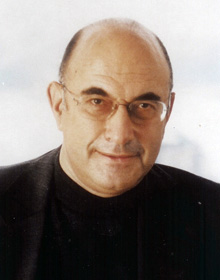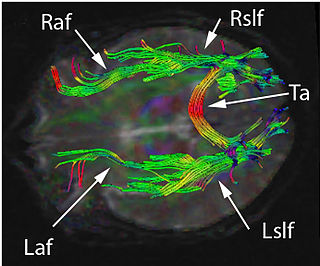
Cognitive neuroscience is the scientific field that is concerned with the study of the biological processes and aspects that underlie cognition, with a specific focus on the neural connections in the brain which are involved in mental processes. It addresses the questions of how cognitive activities are affected or controlled by neural circuits in the brain. Cognitive neuroscience is a branch of both neuroscience and psychology, overlapping with disciplines such as behavioral neuroscience, cognitive psychology, physiological psychology and affective neuroscience. Cognitive neuroscience relies upon theories in cognitive science coupled with evidence from neurobiology, and computational modeling.

Roger Wolcott Sperry was an American neuropsychologist, neurobiologist, cognitive neuroscientist, and Nobel laureate who, together with David Hunter Hubel and Torsten Nils Wiesel, won the 1981 Nobel Prize in Physiology and Medicine for his work with split-brain research. A Review of General Psychology survey, published in 2002, ranked Sperry as the 44th most cited psychologist of the 20th century.

Split-brain or callosal syndrome is a type of disconnection syndrome when the corpus callosum connecting the two hemispheres of the brain is severed to some degree. It is an association of symptoms produced by disruption of, or interference with, the connection between the hemispheres of the brain. The surgical operation to produce this condition involves transection of the corpus callosum, and is usually a last resort to treat refractory epilepsy. Initially, partial callosotomies are performed; if this operation does not succeed, a complete callosotomy is performed to mitigate the risk of accidental physical injury by reducing the severity and violence of epileptic seizures. Before using callosotomies, epilepsy is instead treated through pharmaceutical means. After surgery, neuropsychological assessments are often performed.

Hemispatial neglect is a neuropsychological condition in which, after damage to one hemisphere of the brain, a deficit in attention and awareness towards the side of space opposite brain damage is observed. It is defined by the inability of a person to process and perceive stimuli towards the contralesional side of the body or environment. Hemispatial neglect is very commonly contralateral to the damaged hemisphere, but instances of ipsilesional neglect have been reported.
Witzelsucht is a set of rare neurological symptoms characterized by a tendency to make puns, or tell inappropriate jokes or pointless stories in socially inappropriate situations. It makes one unable to read sarcasm.

A corpus callosotomy is a palliative surgical procedure for the treatment of medically refractory epilepsy. The procedure was first performed in 1940 by William P. van Wagenen. In this procedure, the corpus callosum is cut through, in an effort to limit the spread of epileptic activity between the two halves of the brain. Another method to treat epilepsy is vagus nerve stimulation.
Bicameral mentality is a hypothesis introduced by Julian Jaynes who argued human ancestors as late as the ancient Greeks did not consider emotions and desires as stemming from their own minds but as the consequences of actions of gods external to themselves. The theory posits that the human mind once operated in a state in which cognitive functions were divided between one part of the brain that appears to be "speaking" and a second part that listens and obeys—a bicameral mind—and that the breakdown of this division gave rise to consciousness in humans. The term was coined by Jaynes, who presented the idea in his 1976 book The Origin of Consciousness in the Breakdown of the Bicameral Mind, wherein he makes the case that a bicameral mentality was the normal and ubiquitous state of the human mind as recently as 3,000 years ago, near the end of the Mediterranean bronze age.

The lateralization of brain function is the tendency for some neural functions or cognitive processes to be specialized to one side of the brain or the other. The median longitudinal fissure separates the human brain into two distinct cerebral hemispheres, connected by the corpus callosum. Although the macrostructure of the two hemispheres appears to be almost identical, different composition of neuronal networks allows for specialized function that is different in each hemisphere.

Hemianopsia, or hemianopia, is a loss of vision or blindness (anopsia) in half the visual field, usually on one side of the vertical midline. The most common causes of this damage are stroke, brain tumor, and trauma.

Elkhonon Goldberg is a neuropsychologist and cognitive neuroscientist known for his work in hemispheric specialization and the "novelty-routinization" theory.
The Herrmann Brain Dominance Instrument (HBDI) is a system to measure and describe thinking preferences in people, developed by William "Ned" Herrmann while leading management education at General Electric's Crotonville facility. It is a type of cognitive style measurement and model, and is often compared to psychological pseudoscientific assessments such as the Myers-Briggs Type Indicator, Learning Orientation Questionnaire, DISC assessment, and others.

In human neuroanatomy, brain asymmetry can refer to at least two quite distinct findings:
Elizabeth Kerr Warrington FRS is a British neuropsychologist specialised in the study of dementia. She holds a PhD in Psychology visual processing and is now an emeritus professor of clinical neuropsychology at the University College London. She formerly worked as the Head of the Department of Neuropsychology at the National Hospital for Neurology and Neurosurgery where she is also a member of the Dementia Research Centre. She was made a Fellow of the Royal Society in 1986.

In neuroscience, functional specialization is a theory which suggests that different areas in the brain are specialized for different functions.
Emotional lateralization is the asymmetrical representation of emotional control and processing in the brain. There is evidence for the lateralization of other brain functions as well.
Dichotic listening is a psychological test commonly used to investigate selective attention and the lateralization of brain function within the auditory system. It is used within the fields of cognitive psychology and neuroscience.

The left-brain interpreter is a neuropsychological concept developed by the psychologist Michael S. Gazzaniga and the neuroscientist Joseph E. LeDoux. It refers to the construction of explanations by the left brain hemisphere in order to make sense of the world by reconciling new information with what was known before. The left-brain interpreter attempts to rationalize, reason and generalize new information it receives in order to relate the past to the present.

Disconnection syndrome is a general term for a collection of neurological symptoms caused – via lesions to associational or commissural nerve fibres – by damage to the white matter axons of communication pathways in the cerebrum, independent of any lesions to the cortex. The behavioral effects of such disconnections are relatively predictable in adults. Disconnection syndromes usually reflect circumstances where regions A and B still have their functional specializations except in domains that depend on the interconnections between the two regions.
Dual consciousness is a hypothesis or concept in neuroscience. It is proposed that it is possible that a person may develop two separate conscious entities within their one brain after undergoing a corpus callosotomy. The idea first began circulating in the neuroscience community after some split-brain patients exhibited alien hand syndrome (AHS), which led some scientists to believe that there must be two separate consciousnesses within the brain's left and right hemispheres in competition with one another once the corpus callosum is severed.

Of Two Minds: The Revolutionary Science of Dual-Brain Psychology is a book written by the American psychiatrist Fredric Schiffer wherein he proposes that each person behaves as if there are two minds within the person, and that by recognizing and relating to the two separate minds, the therapist can promote healing and understanding of problems such as depression, anxiety, addictive behavior and delusional thoughts. The author writes that by "two minds in one person" he means that a "part of an individual ...has a unique set of memories, motivations, and behaviors alongside another part of him which has a different unique set of memories, motivations and behaviors." The author locates a "mind" in each of the two physical halves (hemispheres) of the brain. and he "maintains that one hemisphere can be more immature than the other and that this imbalance leads to different mental disorders". During his counseling, as an exercise he has his patients cover all of one eye, and the inner half of the other eye, which the author feels selectively stimulates one cerebral hemisphere more than the other – activating the thoughts and feelings of that hemisphere – which allows one to "'talk' to each half of the brain separately, to learn which is less mature, and to bring the two hemispheres into harmony".













